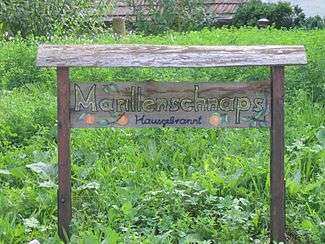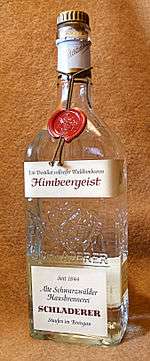Schnapps
Schnapps (/ʃnɑːps/ or /ʃnæps/) or schnaps is a type of alcoholic beverage that may take several forms, including distilled fruit brandies,[1] herbal liqueurs, infusions, and "flavored liqueurs" made by adding fruit syrups, spices, or artificial flavorings to neutral grain spirits.

The English loanword "schnapps" is derived from the colloquial German word Schnaps [ʃnaps] (![]()
European
The German term Schnaps refers to any kind of strong alcoholic drink,[6] similar to how eau de vie (water of life) is used in French, aguardiente (burning water) in Spanish, or aguardente Portuguese.
Fruit

In Austria, Switzerland, southern Germany, and the French region of Alsace, a type of schnapps called Obstler or Obstbrand (from the German Obst, fruit)[7] is very popular. Obstler, which are fruit brandies, are mainly associated with the southern part of the German-language area. In northern Germany, almost all traditional distilled beverages are grain-based.
The main kinds of fruit used for German schnapps are apples, pears, plums, cherries, and apricots. Fruits other than these five are rarely used. Apples are used along with pears to make Obstwasser (fruit water); pears are used to produce Poire Williams (Williamsbirne, William's pear); several types of plums make Zwetschgenwasser (plum water); cherries make Kirschwasser (cherry water); and apricots are used to make Austrian Marillenschnaps (apricot brandy).
The different kinds of Obstler are similar to the varieties of Rakija found in the Balkans and Eastern Europe. Slivovitz is a popular schnapps made from Damson plums found throughout the region.
The most popular schnapps in the UK is Peach Schnapps.[8] It can be enjoyed in many ways, most prefer it on the rocks or mixed with other drinks to form a variety of cocktails.[9] It is made by adding peach flavouring to a neutral grain spirit. It is typically clear and has a strong sweet taste. It became popular in the UK in the 1970's and 1980's.[10] The leading brand is Archers but some large supermarkets do have their own branded peach schnapps which is sold at a reduced price.[11] Archers peach schnapps is more similar to the American style of schnapps.
Neutral Spirit
Many liqueurs referred to as schnapps, but distinct from Obstler, are created by addition of herbal or fruit flavors to a neutral spirit by various methods. The neutral spirit used can vary by location and tradition.
Kräuterlikör (herbal liqueur) is similar to Italian Amaro (liqueur). Well known brands include Jägermeister, Underberg, Kuemmerling, Killepitsch and Wurzelpeter.
Himbeergeist (raspberry spirit) is an infusion of macerated fresh berries in neutral spirits,[12][13] which have been steeped for several weeks before being distilled.
American
An inexpensive heavily sweetened form of liqueur[14] is made in America by mixing neutral grain spirit with fruit syrup, spices, or other flavors. Referred to as "schnapps",[6] these are bottled with an alcohol content typically between 15% and 20% ABV (30–40 proof), though some may be much higher.
See also
- Brandy – Spirit produced by distilling wine
- Korn (liquor) – German colorless grain spirit
- Pálinka – Central European alcohol
- Snaps
References
| Wikimedia Commons has media related to Schnapps. |
- "schnapps - Definition of schnapps in US English by Oxford Dictionaries". Oxford Dictionaries - English. Archived from the original on 4 March 2016. Retrieved 29 April 2018.
- The American Heritage Dictionary of the English Language. Boston: Houghton Mifflin Harcourt. 2011. p. 1562. ISBN 978-0-547-04101-8.
- Wahrig: Deutsches Wörterbuch (Munich: Bertelsmann, 2006). See Branntwein at p. 298 and Schnaps at p. 1305.
- Duden; Definition of Schnaps (in German). "Archived copy". Archived from the original on 2017-04-24. Retrieved 2017-03-25.CS1 maint: archived copy as title (link)
- Kluge: Etymologisches Wörterbuch der deutschen Sprache, 23., erweiterte Auflage (Berlin: Walter de Gruyter, 1999), 734.
- Prial, Frank (27 October 1985). "Schnapps, the Cordial Spirit". The New York Times. Retrieved 31 July 2018.
- Wahrig: Deutsches Wörterbuch (Munich: Bertelsmann, 2006). See Obstler at p. 1087, "aus einer Obstsorte hergestellter Branntwein."
- Clark, Matthew (2020). "Archers Peach Schnapps". Matthew Clark. Retrieved 1 June 2020.
- Graham, Colleen (9 May 2020). "20 Deliciously Sweet Peach Schnapps Cocktails". The Spruce Eats. Retrieved 1 June 2020.
- Magyarics, Kelly (24 May 2019). "What the #$@! Do I Do with This? Peach Schnapps. What It Is and How to Use It". Liquor.com. Retrieved 1 June 2020.
- "ASDA Peach Schnapps". ASDA groceries. 2020. Retrieved 1 June 2020.
- Die Schnapsbrenner Archived 2008-04-10 at the Wayback Machine Detailed description of the method of production, in German.
- Fachlexikon Archived 2007-10-09 at the Wayback Machine General information about the production of Schnaps, including Himbeergeist, in German.
- Lichine, Alexis. Alexis Lichine’s New Encyclopedia of Wines & Spirits (New York: Alfred A. Knopf, 1987), 306–307.